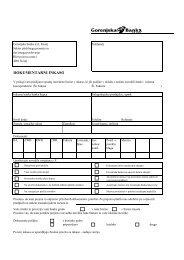Create successful ePaper yourself
Turn your PDF publications into a flip-book with our unique Google optimized e-Paper software.
The calculation of present value of the estimated future cash flows of collateralised financial assets<br />
reflects the cash flows that may result from foreclosure less costs for obtaining and selling the<br />
collateral, whether or not foreclosure is probable.<br />
For the purpose of collective evaluation of impairment, financial assets are grouped in groups from<br />
A to E on the basis of similar credit risk characteristics that include financial condition of the client,<br />
its ability to generate adequate cash flow to repay the loan, received collateral and past experience<br />
with the client.<br />
Future cash flows in a group of financial assets that are collectively evaluated for impairment are<br />
estimated on the basis of the contractual cash flows and historical loss experience for assets with<br />
credit risk characteristics similar to those in the group. The methodology and assumptions used for<br />
estimating future cash flows are reviewed regularly.<br />
Methodology is based on the migration matrices (among groups A to E) for the years 1998 to 2011.<br />
Migration of a client to group E is considered a loss event for the Bank. The amount of impairment<br />
needed is calculated from the probability that a client will migrate from groups A, B, C and D into<br />
group E in the period of five years. To calculate expected loss the probability of migration to group E<br />
is multiplied by the average loss that the bank had with exposures classified in the group E in the past.<br />
If the amount of the impairment subsequently decreases due to an event occurring after the write<br />
down, the reversal of loss is credited as a reduction of an allowance for loan impairment.<br />
When a loan is uncollectable, it is written off against the related provision for loan impairment. Such<br />
loans are written of after all the necessary procedures have been completed and the amount of the<br />
loss has been determined. Subsequent recoveries of amounts previously written off decrease the<br />
amount of the provision for loan impairment in the income statement.<br />
2.11.2. Assets classified as available for sale, measured at fair value<br />
The Bank assesses at each reporting date whether there is objective evidence that a financial<br />
asset or group of financial assets should be impaired. In the case of equity investments classified<br />
as available for sale, a significant or prolonged decline in the fair value of the security below its cost<br />
is considered in determining whether the assets need to be impaired. If any such evidence exists<br />
for available for sale financial assets, the cumulative loss - measured as the difference between the<br />
acquisition cost and current fair value, less any impairment loss on that financial asset previously<br />
recognised in profit or loss - is removed from other comprehensive income and recognised in the<br />
income statement. Impairment losses recognised in the income statement on equity instruments<br />
are not reversed through the income statement. If, in a subsequent period, the fair value of a debt<br />
instrument classified as available for sale increases and the increase can be objectively related to<br />
an event occurring after the impairment loss was recognised in profit or loss, the impairment loss is<br />
reversed through the income statement.<br />
2.12. Intangible assets<br />
Intangible assets, which relate solely to software licences and the licences for their use, are stated at cost,<br />
less accumulated amortisation and impairment losses. Amortisation is provided on a straight-line basis<br />
at rates designed to write off the cost of software over its estimated useful life, not exceeding a period of<br />
ten years. Assets in the course of transfer, construction or implementation are not amortised until they<br />
are brought into use. The term and method of depreciation for intangible assets with a determinable<br />
useful life are reviewed at the end of each financial year.<br />
65<br />
<strong>Gorenjska</strong> <strong>banka</strong>, d. d., Kranj<br />
<strong>Annual</strong> <strong>Report</strong> 2011<br />
Financial <strong>Report</strong>



